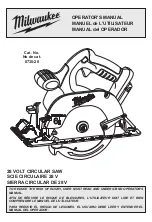
28
| English
Maximum cutting depth
(0°/0°): 70 mm
Replacing insert plates (see figure L)
The insert plates
(23)
can become worn after prolonged use
of the power tool.
Replace faulty insert plates.
– Bring the power tool into the work position.
– Loosen the screws
(43)
using the hex key
(35)
and re-
move the old insert plates.
– Insert the new right-hand insert plate.
– Screw the insert plate as far as possible to the right with
the screws
(43)
so that the saw blade does not come into
contact with the insert plate over the entire length of the
possible slide motion.
– Repeat the work steps in the same manner for the new
left-hand insert plate.
Sawing
Sawing without slide movement (cutting off) (see figure
M)
– For cuts without slide movement (small workpieces),
loosen the locking screw
(11)
if it is tightened. Push the
tool arm all the way towards the
(6)
and
(21)
fences and
re-tighten the locking screw
(11)
.
– Set the required mitre and/or bevel angle as necessary.
– Press the workpiece firmly against the
(6)
and
(21)
fences.
– Firmly clamp the workpiece as appropriate for its dimen-
sions.
– Switch on the power tool.
– Push the locking switch
(17)
and slowly guide the tool
arm downwards using the handle
(16)
.
– Saw through the workpiece applying uniform feed.
– Switch off the power tool and wait until the saw blade has
come to a complete stop.
– Slowly guide the tool arm upwards.
Sawing with slide movement
– For cuts made using the slide device
(12)
(wide work-
pieces), loosen the locking screw
(11)
if it is tightened.
– Set the required mitre and/or bevel angle as necessary.
– Press the workpiece firmly against the
(6)
and
(21)
fences.
– Firmly clamp the workpiece as appropriate for its dimen-
sions.
– Pull the tool arm away from the
(6)
and
(21)
fences until
the saw blade is in front of the workpiece.
– Switch on the power tool.
– Push the locking switch
(17)
and slowly guide the tool
arm downwards using the handle
(16)
.
– Now push the tool arm towards the
(6)
and
(21)
fences,
and saw through the workpiece applying uniform feed.
– Switch off the power tool and wait until the saw blade has
come to a complete stop.
– Slowly guide the tool arm upwards.
Special workpieces
When sawing curved or round workpieces, these must be es-
pecially secured against slipping. At the cutting line, there
should be no gap between the workpiece, fence and saw
table.
If necessary, you will need to manufacture special fixtures.
Checking and Adjusting the Basic Settings
To ensure precise cuts, the basic settings of the power tool
must be checked and adjusted as necessary after intensive
use.
Experience and suitable special tools are required for this.
A Bosch after-sales service point will handle this work
quickly and reliably.
Setting the Standard 0° Bevel Angle
– Bring the power tool into the transport position.
– Turn the saw table
(22)
to the 0° detent
(28)
. The lever
(26)
must be felt to engage in the detent.
Checking (see figure N1)
– Set an angle gauge to 90° and place it on the saw table
(22)
.
The leg of the angle gauge must be flush with the saw blade
(39)
along its entire length.
Setting (see figure N2)
– Loosen the clamping handle
(10)
.
– Loosen the lock nut of the stop screw
(33)
using a com-
mercially available box-ended or open-ended spanner
(size
10
mm).
– Turn the stop screw as far in or out as needed until the leg
of the angle gauge is flush with the saw blade along its en-
tire length.
– Retighten the clamping handle
(10)
.
– Then retighten the stop screw lock nut
(33)
.
If the angle indicator
(32)
is not aligned with the 0° mark on
the scale
(31)
following adjustment, loosen the screw
(44)
using a commercially available cross-headed screwdriver
and align the angle indicator along the 0° mark.
Setting the standard 45° bevel angle
– Bring the power tool into the work position.
– Turn the saw table
(22)
to the 0° detent
(28)
. The lever
(26)
must be felt to engage in the detent.
– Loosen the clamping handle
(10)
and use the handle
(16)
to swivel the tool arm all the way to the left (45°).
Checking (see figure O1)
– Set an angle gauge to 45° and place it on the saw table
(22)
.
The leg of the angle gauge must be flush with the saw blade
(39)
along its entire length.
Setting (see figure O2)
– Loosen the clamping handle
(10)
.
– Loosen the lock nut of the stop screw
(9)
using a com-
mercially available box-ended or open-ended spanner
(size
10
mm).
1 609 92A 5UB | (22.10.2020)
Bosch Power Tools
Содержание 0.601.B19.000
Страница 5: ... 5 1 2 3 A B1 B2 3 2 3 3 3 2 35 1 1 1 27 Bosch Power Tools 1 609 92A 5UB 22 10 2020 ...
Страница 6: ...6 C1 C2 C3 C4 35 29 36 37 17 19 38 39 1 609 92A 5UB 22 10 2020 Bosch Power Tools ...
Страница 7: ... 7 G D E H 30 F 35 40 6 3 2 42 7 41 28 24 26 22 Bosch Power Tools 1 609 92A 5UB 22 10 2020 ...
Страница 8: ...8 I J K L M 8 34 32 10 15 17 43 23 11 6 21 1 609 92A 5UB 22 10 2020 Bosch Power Tools ...
Страница 9: ... 9 90 45 N1 N2 O1 O2 P Q 44 6 32 31 33 9 5 24 25 Bosch Power Tools 1 609 92A 5UB 22 10 2020 ...
Страница 334: ...334 1 609 92A 5UB 22 10 2020 Bosch Power Tools ...
















































